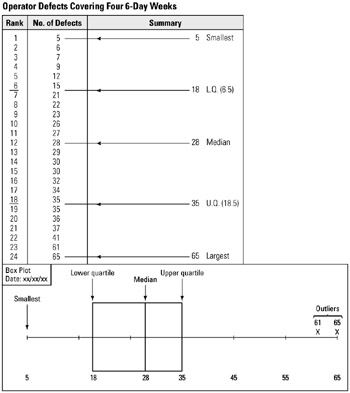Tool 19: Box Plot
| AKA | Box and Whisker Plot |
| Classification | Analyzing/Trending (AT) |
Tool description
The box plot illustrates a distribution of data showing location and spread of values, skewness, and possible outliers (extremely high or low scores). Although a box plot is less detailed than a histogram, it is quite useful in that it will display extreme variations in the data plotted.
Typical application
-
To identify outliers in a data set.
-
To compare groups of data for significant differences in patterns.
-
To check for improvement in data after a process change has been made.
Problem-solving phase
| Select and define problem or opportunity | |
| → | Identify and analyze causes or potential change |
| Develop and plan possible solutions or change | |
| Implement and evaluate solution or change | |
| → | Measure and report solution or change results |
| Recognize and reward team efforts |
Typically used by
| 1 | Research/statistics |
| Creativity/innovation | |
| 3 | Engineering |
| Project management | |
| 2 | Manufacturing |
| Marketing/sales | |
| Administration/documentation | |
| Servicing/support | |
| Customer/quality metrics | |
| Change management |
before
-
Data collection strategy
-
Stem and Leaf Display
-
Observation
-
Dot Diagram
-
Sampling Methods
after
-
Variance Analysis
-
Problem analysis
-
Process analysis
-
Potential problem analysis (PPA)
-
What-If Analysis
Notes and key points
Use the follwing equation to calculate ranks for quartiles:
-
For this example:
-
– Median rank=

-
– Rank of lower quartile (L.Q.)=

-
– Rank of upper quartile (U.Q.)= (n + 1) − L.Q. = (24 + 1) − 6.5 = 18.5
-
To identify outliers use the following:
-
– Check for larger data values:

-
– Therefore defect scores 61 and 65 are outliers at the high end of the distribution.
-
– Check for smaller data values:

-
– The lowest data value = 5; therefore there is no outlier at the low end of the distribution.
Step-by-step procedure
-
STEP 1 Data is collected and identified by recording the collection period, data source, and exact description of what is supposed to be measured. See example Operator Defects Covering Four 6-Day Weeks.
-
STEP 2 A table of rank-ordered data is constructed and median, lower and upper quartiles calculated. See notes and key points for the calculations used in this example.
-
STEP 3 A box plot is constructed as shown. Ensure that outliers are identified and marked.
-
STEP 4 Check all data values, box plot dimensions and outlier values, date the plot, and make final notes on the pattern or variation of the data.
Example of tool application

EAN: 2147483647
Pages: 326